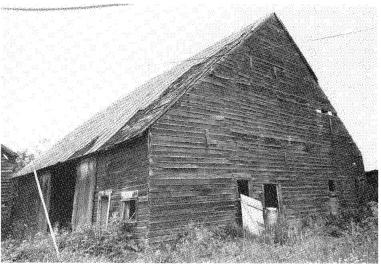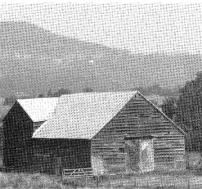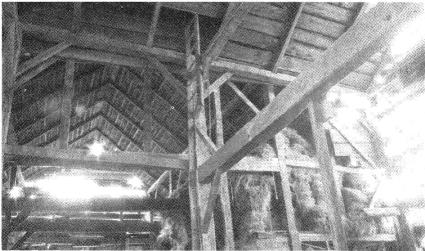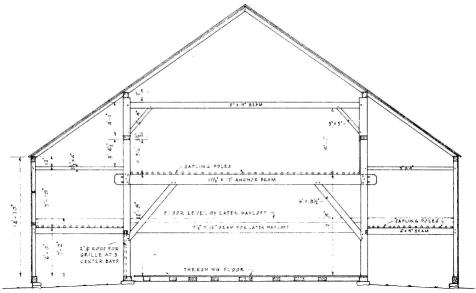|
Dutch
Barn Preservation Society
Dedicated
to the Study and Preservation
of New World Dutch Barns
NEWSLETTER,
FALL 1998 VOL. 1, ISSUE 2
Agrarian
Changes: Learning from Barn Additions
By Neil Larson
Dutch barns are extraordinarily rich documents of life in our past.
Built across two centuries and adapted to new uses for another
one hundred years, the barns are a fusion of Old World traditions
and New World innovations; their evolution offers insight into
a changing agricultural society and illustrates evolving building
technology.
Originally, Dutch barns were designed for use in the growing,
storing and processing of wheat. The wheat industry dominated the
Hudson Valley economy until the early nineteenth century; in the
Schoharie and Mohawk valleys, wheat was the major crop into the
1840's. In each region, as blights occurred and rising non-farm
populations increased the demand for fresh market products, large-scale
crop farming shifted from wheat-growing to milk production. Nearly
all of the surviving unrestored Dutch barns show evidence of alterations
to meet the requirements of changing farming practices. These alterations
often make it difficult to discern the original appearance and
functions of the barns, but a study of these additions and renovations
provides an understanding of the barn in the context of the changing
occupational patterns and cultural attitudes of the ethnic communities
that built the barns and continued to use them.
When the function of the Dutch barn changed to accommodate dairying,
the spaces within it were rearranged and augmented to house more
animals, to provide easier access to the fronts and rears of animals
for feeding, cleaning and milking, and to store hay in addition
to grain.

The early eighteenth century Johannes Skinkle Barn
on Route 9H, Columbia County, NY was altered by the insertion
of new wagon doors. The original door openings in the gable ends
were covered with siding. Photo by Shirley Dunn.
One popular alteration was rotating the center aisle axis 90
degrees and inserting new doors on the side walls, creating a plan
more akin to English barns of the period. In addition to increasing
the space for animals, changing the access so that the aisle went
between anchor beams rather than under them allowed more headroom
for hay wagons. Most other existing barn types in New York State
and elsewhere were also modified in this dairying period as moving
and storing hay more easily within the barn became a matter of
major concern. (Dutch barns actually accommodated hay track systems
better than English barns since their roof framing did not rely
on collar beams.)
The reorganization of interior storage space for feed and bedding
was easily accomplished; however, introducing space for an increased
number of cows required physical alterations to the barn. If an
addition was not feasible, farmers would construct stanchions in
the side aisles or at one end under a hay mow. In some cases, an
entire floor was constructed just under the anchor beams to create
a cow house on the ground level and hay storage above, but this
must have been done after grain was no longer threshed in the barn.
A more radical solution was to raise the old barn on a stone basement.
This innovation was a direct response to the progressive agricultural
literature of the period, which advocated housing livestock at
a basement level for ease of handling and feeding.
Raising the roof was an alternative for increasing the volume
of Dutch barns, at least in the western reaches of the Hudson Valley,
where a few examples survive. New sections of posts approximately
five feet high were inserted above existing posts and purlins.
New purlins with braces then tied the new posts together. In the
illustrated example, the original roof framing was apparently reused,
necessitating elevating the side walls an equal height. The direct
result of this change was increased capacity for hay storage; however,
physical evidence suggests that it usually coincided with a complete
reorganization of space within the barn which created cow stalls
in a side aisle and at one end of the barn.
In addition to adding to the tops and bottoms of Dutch barns,
farmers increased barn size by adding to the ends. Field investigations
indicate that the common choice for an addition was to extend the
length of the barn with construction of a similar form along the
same roof axis, in effect creating a longer, rectangular barn.
Side doors, ramps into upper level hay mows, excavated basements
and other alterations were often introduced at the same time. In
the Schoharie Valley, while end additions were sometimes made,
there are a number of examples unique to that region in which separate
rectangular barn frames were abutted perpendicularly to the ridge
line of the old Dutch barns.

The Godigheit Barn, Schoharie County, NY shows
a perpendicular addition at the rear that was typical of the
Schoharie Valley. Photo by Harold Zoch.

View of interior of the Godigheit Barn is from
the addition looking into the old Dutch barn in the background.
Photo by Harold Zoch.
 New
4'8" sections were added to the posts above the existing
purlins to raise the roof on the Johannes Decker Barn, Shawangunk,
Ulster County, NY. New purlins were added to support the roof
rafters. All new members were mill-sawn with a circular blade.
Posts were sawn with a tongue to overlap the old post and bolted
fast. Note hayloft added in rear creating animal space below. Historic
American Buildings Survey: New
4'8" sections were added to the posts above the existing
purlins to raise the roof on the Johannes Decker Barn, Shawangunk,
Ulster County, NY. New purlins were added to support the roof
rafters. All new members were mill-sawn with a circular blade.
Posts were sawn with a tongue to overlap the old post and bolted
fast. Note hayloft added in rear creating animal space below. Historic
American Buildings Survey:
Construction in additions sometimes replicated the Dutch methods
but in every case the new structures were in sharp contrast to
the old, with later builders often using less substantial materials
and displaying far less concern for craftsmanship than had the
original builder.
Dutch barns are "Dutch" as much for the cultural group
they came to symbolize as for their form and structure. Their distinctive
construction method was derived from the well established aisled
barn tradition of northern Europe. The "Dutch" -ness
of these barns, however, is actually less dramatic in their direct
transplantation in the seventeenth century from the wheat-growing
areas of northern Europe to the wheat-growing areas of colonial
New York and New Jersey than in the persistence of their image
on the landscape in the rapidly changing society and economy of
this region following the Revolution.
With nationhood, rural ethnic communities in these old "Dutch"
valleys were forced to defend their identities against the onslaught
of vast numbers of newcomers and the snowballing momentum of
the frantic popular culture wrought by independence and the idea
of unlimited opportunity. Therefore, while Dutch barns were being
transformed to new functional requirements, the region was in
the midst of a battle between old and new, for cultural supremacy
that found vivid expression in politics, religion, social behavior,
the arts. . . and architecture. The amount of conscious, non-essential
effort that went into the construction and preservation of the
Dutch barns suggests that these buildings also served as emblems
of ethnic solidarity. The final analysis of functional changes
in these buildings will not be complete until this expressive
dimension of cultural continuity in their design is addressed.
Neil Larson is Curator for the Dutchess County
Historical Society. He was formerly with the N.Y.S. Field Services
Bureau.
FALL
1988 Newsletter, Part TWO
|